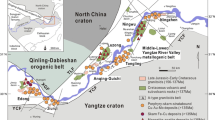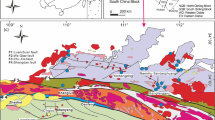Abstract
Diopside-rich, skarn-hosted, copper–gold ore derived primarily from carbonaceous metapelites at Mount Elliott forms a distinctive member of the spectrum of Cu–Au–(Fe oxide) deposit styles in the Cloncurry district of the Paleoproterozoic to Mesoproterozoic Mount Isa Block. The mine sequence is a package of carbonaceous metapelites and metagreywackes containing amphibolites derived from tholeiitic basic rocks. A 40Ar–39Ar age spectrum with an extensive plateau-like segment at 1,510 ± 3 Ma from an actinolite associated with sulfides is taken to represent the age of mineralization and is identical within error to the ages of most of the nearby batholithic granitoids. The mine sequence is locally intruded by 1- to 10-m-thick late- to post-tectonic trachyandesite dykes, which were emplaced during the hydrothermal activity that created the orebodies and have affinities with the regional high potassium “Eureka” supersuite granitoids. Stable isotope data are consistent with dominantly magmatic fluids during mineralization and the regionally distinctive skarn (Ca–Mg) and Cu–Au–Ni–Co–Te–Se (low Pb–Zn–Ag–Sb) chalcophile element associations may reflect a primitive magmatic fluid source and/or leaching of these elements from country rocks. Mount Elliott is an unusual skarn deposit characterized by pronounced early albitization (K–Fe–Mg depletion) of the host rocks succeeded by predominantly open-space deposition of sodic diopside ± actinolite ± scapolite ± andradite ± magnetite ± sulfides ± apatite ± allanite ± tourmaline ± calcite. The Ca–Fe–Mg(–Na)-rich (manganese-poor) chemistry was imposed from the fluid phase in the absence of carbonate-rich protoliths. Immobile trace element (Ti, Zr, Nb) geochemistry shows that Mount Elliott skarns formed in both metasedimentary and mafic metavolcanic host rocks, but the former are the main hosts of ore in upper and lower ore zones that represent most of the resource. Banded skarns derived from a distinct calc-silicate/marble package at the nearby SWAN prospect have higher Nb/TiO2 and Zr/TiO2 ratios than the Mount Elliott metasediment-derived skarns, consistent with different provenance of the detrital components in the two sequences. Medium- to coarse-grained massive skarn and skarn breccia in the Mount Elliott lower ore zone formed in pelites and the trachyandesite dykes are the only intrusive rocks that could be genetically related to the mineralization in the immediate vicinity of the orebodies.
Similar content being viewed by others
Author information
Authors and Affiliations
Additional information
Received: 1 September 1999 / Accepted: 28 September 2000
Rights and permissions
About this article
Cite this article
Wang, S., Williams, P. Geochemistry and origin of Proterozoic skarns at the Mount Elliott Cu–Au(–Co–Ni) deposit, Cloncurry district, NW Queensland, Australia. Mineral. Deposita 36, 109–124 (2001). https://doi.org/10.1007/s001260050292
Issue Date:
DOI: https://doi.org/10.1007/s001260050292




